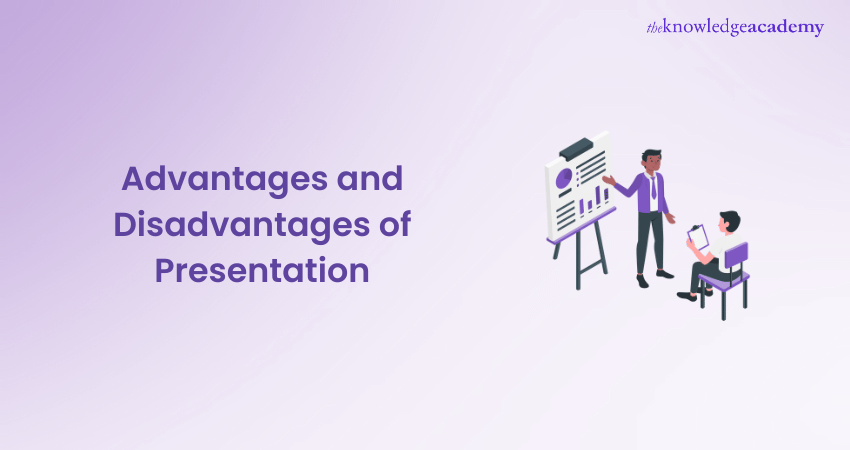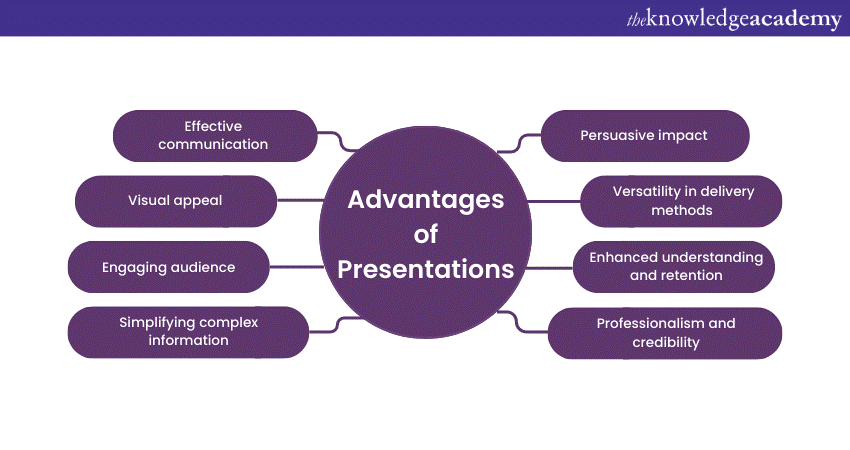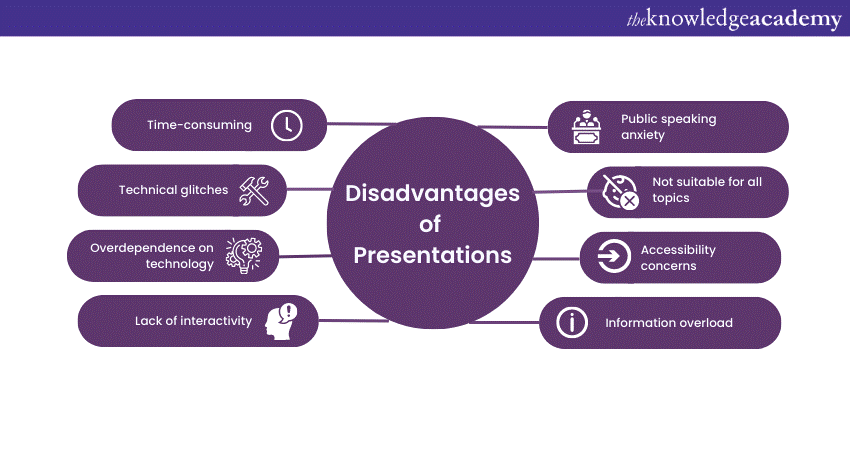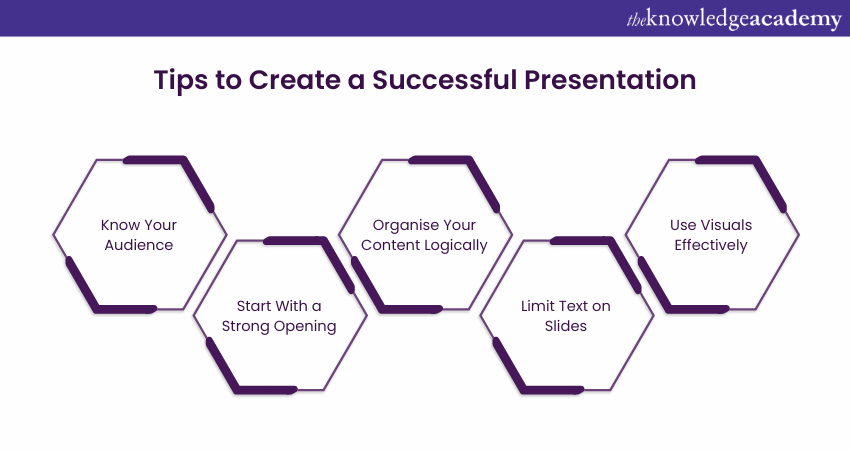We may not have the course you’re looking for. If you enquire or give us a call on +61 272026926 and speak to our training experts, we may still be able to help with your training requirements.
We ensure quality, budget-alignment, and timely delivery by our expert instructors.

Have you ever wondered why some Presentations captivate audiences while others fall flat? Or how you can leverage the strengths of Presentations to enhance your communication skills? Presentations are a strong tool for conveying information, but what are the Advantages and Disadvantages of Presentation methods? In this blog, we’ll explore the key benefits and potential drawbacks of using Presentations in various settings.
Understanding the Advantages and Disadvantages of Presentation techniques can help you make informed decisions about when and how to use them effectively. Ready to elevate your Presentation game and avoid common pitfalls? Let’s dive in and discover the best practices for creating impactful Presentations!
Table of Contents
1) What is a Presentation: A Brief Introduction
2) Advantages of Presentations
3) Disadvantages of Presentations
4) How to Make a Successful Presentation?
5) Conclusion
What is a Presentation: A Brief Introduction
A Presentation is a method of conveying information, ideas, or data to an audience using visual aids and spoken words. It can be formal or informal and is used in various settings, including business meetings, educational environments, conferences, and public speaking engagements. Presenters use visual elements like slides, charts, graphs, images, and multimedia to support and enhance their spoken content. The aim is to engage the audience, communicate the message effectively, and leave a lasting impact by focusing on the key elements of presentation skills..
The success of a Presentation hinges on the presenter’s ability to organise content coherently, engage the audience, and deliver information clearly and compellingly. Moreover, Presentation Skills are applicable to a wide range of scenarios, from business proposals and academic research to sales pitches and motivational speeches.
Advantages of Presentations
Presentations have become an indispensable tool in various spheres of life, owing to their numerous advantages. Let's delve deeper into their offered advantages:

1) Effective Communication
One of the primary advantages of Presentations is their ability to facilitate effective communication. Whether you're addressing a small group of colleagues or a large audience at a conference, Presentations help you to convey your message clearly and succinctly. By structuring your content and using visuals, you can ensure that your key points are highlighted and easily understood by the audience.
2) Visual Appeal
"Seeing is believing," and Presentations capitalise on this aspect of human psychology. The use of visuals, such as charts, graphs, images, and videos, enhances the overall appeal of the content. These visual aids not only make the information more engaging but also help reinforce the main ideas, making the Presentation more memorable for the audience.
3) Engaging the Audience
Captivating your audience's attention is crucial for effective communication. Presentations provide ample opportunities to engage your listeners through various means. By incorporating storytelling, anecdotes, and real-life examples, you can nurture an emotional connection with your audience. Additionally, interactive elements like polls, quizzes, and group activities keep the audience actively involved throughout the Presentation.
4) Simplifying Complex Information
Complex ideas and data can often be overwhelming, making it challenging to convey them effectively. However, Presentations excel in simplifying intricate information. By simplifying complex concepts into clear and interconnected slides, you can present the information in a logical sequence, ensuring that the audience grasps the content more easily.
Revolutionise your classroom experience with our Blended Learning Essentials Course – book your spot now!
5) Persuasive Impact
Presentations are powerful tools for persuasion and influence. Whether you're convincing potential clients to invest in your product, advocating for a particular cause, or delivering a motivational speech, a well-crafted Presentation can sway the audience's opinions and inspire action. The combination of visual and verbal elements enables you to make a compelling case for your ideas, leaving a lasting impact on the listeners.
6) Versatility in Delivery Methods
Another advantage of Presentations lies in their flexibility and versatility in terms of delivery methods. Gone are the days when Presentations were limited to in-person meetings. Today, technology allows presenters to reach a wider audience through various platforms, including webinars, online videos, and virtual conferences. This adaptability makes Presentations an ideal choice for modern communication needs.
7) Enhanced Understanding and Retention
When information is presented in a visually appealing and structured manner, it aids in better understanding and retention. Human brains process visuals faster and more effectively than plain text, making Presentations an ideal medium for conveying complex concepts. The combination of visual elements and spoken words create a multi-sensory experience, leading to increased information retention among the audience.
8) Professionalism and Credibility
In professional settings, well-designed Presentations lend an air of credibility and professionalism to the presenter and the topic being discussed. A thoughtfully crafted Presentation shows that the presenter has put effort into preparing and organising the content, which in turn enhances the audience's trust and receptiveness to the information presented. Explore more on the principles of presentation to improve your skills.
Learn to captivate any audience with confidence and clarity – join our Presentation Skills Course and transform your communication abilities!
Disadvantages of Presentations
While Presentations offer a host of benefits, they are not without their drawbacks. Let's explore some of the disadvantages that presenters and audiences may encounter when you Prepare a Presentation:

1) Time-consuming
Creating a compelling Presentation can be a time-consuming process. From researching and gathering relevant information to designing visually appealing slides, a significant amount of effort goes into ensuring that the content is well-structured and impactful. This time investment can be challenging, especially when presenters have tight schedules or are faced with last-minute Presentation requests.
2) Technical Glitches
Presentations heavily rely on technology, and technical glitches can quickly turn a well-prepared Presentation into a frustrating experience. Projectors may malfunction, slides might not load correctly, or audiovisual components may fail to work as expected, as outlined in the Audio Visual Aids Guide. Dealing with such technical issues during a Presentation can disrupt the flow and distract both the presenter and the audience.
Turn raw data to actionable insights with our Data Analysis Skills Training – join us and advance your analytical abilities!
3) Overdependence on Technology
In some cases, presenters may become overly reliant on the visuals and technology, neglecting the importance of direct engagement with the audience. Overloaded slides with excessive text can make presenters read directly from the slides, undermining the personal connection and interaction with the listeners. This overdependence on technology can lead to a lack of spontaneity and authenticity during the Presentation.
4) Lack of Interactivity
Traditional Presentations, particularly those delivered in large auditoriums, may lack interactivity and real-time feedback. In comparison, modern Presentation formats can incorporate interactive elements; not all Presentations provide opportunities for audience participation or discussions. This one-sided communication can lead to reduced engagement and limited opportunities for clarifying doubts or addressing queries.
5) Public Speaking Anxiety
For many individuals, public speaking can be a nerve-wracking experience. Presenting in front of an audience, especially in formal settings, can trigger anxiety and stage fright. This anxiety may affect the presenter's delivery and confidence, impacting the overall effectiveness of the Presentation. Overcoming public speaking anxiety requires practice, self-assurance, and effective stress management techniques.
6) Not Suitable for all Topics
While Presentations are an excellent medium for conveying certain types of information, they may not be suitable for all topics. Some subjects require in-depth discussions, hands-on demonstrations, or interactive workshops, which may not align well with the traditional slide-based Presentation format. Choosing the appropriate communication method for specific topics is crucial to ensure effective knowledge transfer and engagement.
7) Accessibility Concerns
In a diverse audience, some individuals may face challenges in accessing and comprehending Presentation materials. For example, people with visual impairments may find it difficult to interpret visual elements, while those with hearing impairments may struggle to follow the spoken content without proper captions or transcripts. Addressing accessibility concerns is vital to ensure inclusivity and equal participation for all attendees.
8) Information Overload
Presentations that bombard the audience with excessive information on each slide can lead to information overload. When the audience is overwhelmed with data, they may struggle to absorb and retain the key points. Presenters should strike a balance between providing adequate information and keeping the content concise and focused.
How to Make a Successful Presentation?
Now that we know the Advantages and Disadvantages of Presentations, we will provide you with some tips on how to make a successful Presentation.

1) Understand your audience's needs and interests to tailor your content accordingly.
2) Begin with an attention-grabbing introduction to captivate the audience from the Start of Presentation.
3) Structure your Presentation in a clear and coherent manner with a beginning, middle, and end.
4) Keep slides simple and avoid overcrowding with excessive text; use bullet points and keywords.
5) Incorporate high-quality images, graphs, and charts to enhance understanding and engagement.
6) Rehearse your Presentation multiple times to improve your delivery and confidence.
7) Show passion for your topic and maintain good eye contact to build trust with the audience.
8) Include relevant anecdotes and case studies to make your points more relatable and memorable.
9) Encourage audience participation through questions, polls, or discussions to keep them engaged.
10) Respect the allotted time for your Presentation and pace your delivery accordingly.
11) Summarise your key points and leave the audience with a clear takeaway or call to action.
12) Request feedback after the Presentation to identify areas for improvement and grow as a presenter.
Sign up for our Presenting With Impact Training and transform your Presentations with impactful skills.
Conclusion
Understanding the Advantages and Disadvantages of Presentation methods can significantly enhance your communication skills and audience engagement. By comprehending the strengths and mitigating the weaknesses, you can create impactful Presentations that leave a lasting impression. So, apply these insights and watch your effectiveness soar!
Advance you career with our Business Writing Course – register today and gain the skills to communicate with clarity and confidence.
Frequently Asked Questions
Can Strong Presentation Skills Improve Networking Opportunities?

Strong Presentation skills can boost your ability to clearly and persuasively communicate ideas. This can lead to increased networking opportunities, as people are more likely to connect with and refer to someone who presents confidently and effectively.
Why are Good Presentation Skills Important for Educators and Trainers?

Good Presentation skills are crucial for educators and trainers as they ensure information is delivered clearly and engagingly. Effective Presentations help maintain audience interest, facilitate better understanding, and promote active participation, ultimately leading to improved learning outcomes.
What are the Other Resources and Offers Provided by The Knowledge Academy?

The Knowledge Academy takes global learning to new heights, offering over 3,000 online courses across 490+ locations in 190+ countries. This expansive reach ensures accessibility and convenience for learners worldwide.
Alongside our diverse Online Course Catalogue, encompassing 19 major categories, we go the extra mile by providing a plethora of free educational Online Resources like News updates, Blogs, videos, webinars, and interview questions. Tailoring learning experiences further, professionals can maximise value with customisable Course Bundles of TKA.
What is The Knowledge Pass, and How Does it Work?

The Knowledge Academy’s Knowledge Pass, a prepaid voucher, adds another layer of flexibility, allowing course bookings over a 12-month period. Join us on a journey where education knows no bounds.
What are the Related Courses and Blogs Provided by The Knowledge Academy?

The Knowledge Academy offers various Presentation Skills Training, including the Data Analysis Skills Course, Blended Learning essentials Course, and Business Writing Course. These courses cater to different skill levels, providing comprehensive insights into Presentation Skills.
Our Business Skills Blogs cover a range of topics related to Presentation Skills, offering valuable resources, best practices, and industry insights. Whether you are a beginner or looking to advance your Business Skills, The Knowledge Academy's diverse courses and informative blogs have got you covered.
Upcoming Business Skills Resources Batches & Dates
Date
 Presentation Skills Training
Presentation Skills Training
Fri 7th Mar 2025
Fri 23rd May 2025
Fri 18th Jul 2025
Fri 12th Sep 2025
Fri 14th Nov 2025






 Top Rated Course
Top Rated Course



 If you wish to make any changes to your course, please
If you wish to make any changes to your course, please


